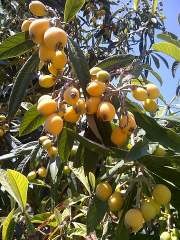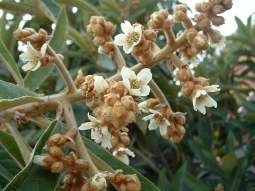Loquat
 Common Name: Loquat, japanese medlar, nispero
Common Name: Loquat, japanese medlar, nispero
Scientific Name: Eriobotrya japonica
Climate: Warm, temperate, cold
Plant Description: A tropical evergreen shrub or tree 4-8 m high. Young stems are stout and covered in a white down, while older stems have leaf scars and become grey-brown and calloused. The tree alternates simple leaves that are ovalish, leathery, veiny, and toothed. The top of the leaf is dark green, glossy and smooth while the bottom is downy, with short hairs. Young leaves are totally brown and hairy. The flowers are born in terminal panicles of 30 to 100 white or ivory flowers. Each flower has 5 petals. They are followed by pear-shaped to roundish fruit with yellow skin covered in downy hair. Fruits grow in groups of 4 to 30. They can be sweet to sub-acid or fully acidic. Each fruit contains from 3 to 5 large seeds that are brown or dark brown in color.
Grows mostly in regions of higher altitude - 900 - 2,100 above sea level.
The loquat is originally from China, where related species can be found growing in the wild.1
Cultivation: Tolerates wet to dry conditions, hot to moderately cool temperatures, most soils, and moderate shade. It tolerates drops in temperature to -12°C without serious damage but the temperature of 7°C kills the bud and -3°C kills the flower, consequently the fruit cannot be born. Where the climate is too cool or excessively warm and moist, the tree is grown as an ornamental but will not bear fruit.
It adapts to a wide variety of soils, but must have good drainage. Loquat prefers growing in full sun.
Seeds are used only when the tree is grown for ornamental purposes or for use as rootstocks. Loquat seeds remain viable for 6 months if stored in partially sealed glass jars and high humidity at room temperature, but the best storage temperature is 5ºC. The seeds are washed and planted in seedlings or in pots and transplanted when they reach a height of 15 to 20 cm. During this period it is important that the soil is well drained while maintaining moisture.
When the stem is 2 cm thick at the base, the plants are ready to be grafted. Gusset grafts2 with 3-month-old buds are feasible.
In propagation through grafted rootstocks, the same variety can be used as scion. The grafting is carried out two years after planting, when the stem is 1.5 cm. diameter. 30 days before planting the holes must be opened and prepared with well decomposed cow manure and agricultural lime. The planting distance varies between 6 and 7 m. the holes must have dimensions of 60 x 60 x 60 cm. After planting the rootstocks, they should be watered abundantly and covered with straw or other material to avoid rapid evaporation of the irrigation water, especially in hotter times, and keep the crop free of weeds.3
Trees that propagate vegetatively will begin to bear fruit in 5 years or less, compared to 8 to 10 years in trees produced by seed.
The fruits reach maturity in 90 days from the full opening of the flower. Maturity is determined by color. The fruits are difficult to harvest due to the thick and hard stem of each fruit that is not easily separated from the bunch, and the fruits must be picked with the attached stem to avoid breaking the skin.
This is a tree that does not need special watering, if there are periods of drought it should be watered frequently, especially when the flowers are sprouting and the fruit is developing. If this is not done the flower will fall, the fruit will wrinkle and lose quality and flavor.
The loquat must be fertilized at all stages of its growth. There should be applied fertilizers rich in potassium and phosphorus. Pruning is necessary to maintain the tree's vitality, and to obtain a plant with open branches and a cup-shaped crown. Proper pruning will later facilitate thinning of the chunks, and bagging of the fruits for protection against attack by pests. Cleaning pruning is performed to eliminate dead or diseased dry branches. It should be done after harvest in order to allow the sunlight to penetrate the inside of the crown.
 Uses: It is eaten as fresh fruit on its own or mixed well with other fruits in fruit salads. The fruits are also used to make jam, jelly, and are often served poached in light syrup. Firm fruits are best for making cakes or pies.
Uses: It is eaten as fresh fruit on its own or mixed well with other fruits in fruit salads. The fruits are also used to make jam, jelly, and are often served poached in light syrup. Firm fruits are best for making cakes or pies.
The fruit is a sedative and is eaten to stop vomiting and thirst. The flowers are considered to have expectorant properties. An infusion of the leaves, or their powder, can be taken to relieve diarrhea and to counteract depression and intoxication from alcoholic beverages.
Loquat extract contains many antioxidants, and they are used to counteract inflammation, diabetes, cancer, bacterial infection, aging, pain, allergy, and other health problems.4
Young branches can be used for forage.
Pests and Diseases: Bagging the fruits is enough to protect against most pests, such as the fruit fly, eastern butterfly, and aphids. When flying insects abound, traps with fruit juices are used. Insecticides should not be used, especially during the flowering season, so as not to affect bees, which play a fundamental role in pollination.
Pests: Bark Eating Caterpillar. Caterpillars feed on the bark and make tunnels in the trunk which may kill the plant. Manage by clearing the holes/tunnels with wire, and injecting kerosene oil.
Shoot/Fruit Blight and Bark Canker (Phoma glumerata sp.) - the canker appears on bud scars, twigs or in crotches. Small circular brown spots appear around a leaf scar or superficial wound. As the canker enlarges the centres become sunken with the surrounding healthy bark. The fungus perpetuates itself on the trees in bark cankers. Control it by removing the cankers and decorticate along with 2 cm of healthy bark. Apply Bordeaux paste (1 kg of copper sulphate and 1 kg of lime in 10 litres of water). Apply on the cut ends and wounds. Spray Bordeaux mixture 2:2: 250 twice at an interval of one month.5
References:
- Li, G. F., Zhang, Z. K., and Lin, S. Q. "Origin and Evolution of Eriobotrya". ISHS Acta Horticulturae 887: III International Symposium on Loquat.
- It is a type of bud graft in which the bark of the tree to be grafted is separated to introduce a portion of bark with a bud (escutcheon) of the desired variety
- http://www.lni.unipi.it/stevia/Supplemento/PAG39011.HTM
- https://www.mdpi.com/1422-0067/17/12/1983
- https://www.yourarticlelibrary.com/plant-diseases/insects-and-diseases-that-occurs-in-loquat-plants-and-measures-to-control-it/24694
En español: Níspero
